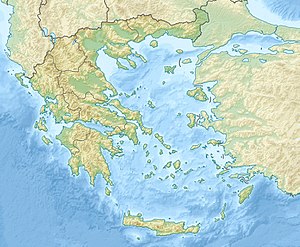
Back Schlacht von Salamis ALS معركة سلاميس (480 ق.م) Arabic Salamin döyüşü Azerbaijani سلامیس دؤیوشو AZB Саламин янындағы һуғыш Bashkir Битка при Саламин Bulgarian Emgann Salamis Breton Bitka kod Salamine BS Batalla de Salamina Catalan Bitva u Salamíny Czech
| Battle of Salamis | |||||||||
|---|---|---|---|---|---|---|---|---|---|
| Part of the Second Persian invasion of Greece | |||||||||
 A map depicting the major areas of conflict during the Battle of Salamis | |||||||||
| |||||||||
| Belligerents | |||||||||
| Greek city-states | Achaemenid Empire | ||||||||
| Commanders and leaders | |||||||||
| Strength | |||||||||
| 371–378 ships[i] | |||||||||
| Casualties and losses | |||||||||
| 40 ships | 300 ships | ||||||||
Location of the naval battle of Salamis within modern Greece | |||||||||
The Battle of Salamis (/ˈsæləmɪs/ SAL-ə-miss) was a naval battle fought in 480 BC, between an alliance of Greek city-states under Themistocles, and the Achaemenid Empire under King Xerxes. It resulted in a victory for the outnumbered Greeks.
The battle was fought in the straits between the mainland and Salamis, an island in the Saronic Gulf near Athens, and marked the high point of the second Persian invasion of Greece. It was arguably the largest naval battle of the ancient world,[7] and marked a turning point in the invasion.[8]
To block the Persian advance, a small force of Greeks blocked the pass of Thermopylae, while an Athenian-dominated allied navy engaged the Persian fleet in the nearby straits of Artemisium. In the resulting Battle of Thermopylae, the rearguard of the Greek force was annihilated, while in the Battle of Artemisium the Greeks suffered heavy losses and retreated after the loss at Thermopylae. This allowed the Persians to conquer Phocis, Boeotia, Attica and Euboea. The allies prepared to defend the Isthmus of Corinth while the fleet was withdrawn to nearby Salamis Island.
Although heavily outnumbered, the Greeks were persuaded by Athenian general Themistocles to bring the Persian fleet to battle again, in the hope that a victory would prevent naval operations against the Peloponnese. Persian king Xerxes was also eager for a decisive battle. As a result of subterfuge on the part of Themistocles (which included a message directly sent to Xerxes letting him know that much of the Greek fleet was stationed at Salamis), the Persian navy rowed into the Straits of Salamis and tried to block both entrances. In the cramped waters, the great Persian numbers were an active hindrance, as ships struggled to maneuver and became disorganized. Seizing the opportunity, the Greek fleet formed in line and achieved a victory.
Xerxes retreated to Asia with much of his army, leaving Mardonius to complete the conquest of Greece. The following year the remainder of the Persian army was defeated at the Battle of Plataea and the Persian navy at the Battle of Mycale. The Persians made no further attempts to conquer the Greek mainland. The battles of Salamis and Plataea thus mark a turning point in the course of the Greco-Persian Wars as a whole; from then onward, the Greek poleis would take the offensive.
- ^ Gongaki (2021).
- ^ Cite error: The named reference
VIII48was invoked but never defined (see the help page). - ^ Ιστορία του Ελληνικού Έθνους 1971
- ^ Demetrius, 1998
- ^ Lazenby p.174
- ^ Roisman, Joseph (2011). Yardley, J.C. (ed.). Ancient Greece from Homer to Alexander: The Evidence. Wiley-Blackwell. p. 235. ISBN 978-1405127769.
Herodotus (7.89.1) estimates that the Persians altogether had 1,207 ships, which modern historians cut to between 400 and 700 ships.
- ^ Krentz, Peter (2020-09-24). "Battle of Salamis: 480 BC". oxfordbibliographies.com. doi:10.1093/OBO/9780199791279-0196. ISBN 978-0-19-979127-9. Retrieved 2024-04-07.
- ^ Beaton, Roderick (2021). The Greeks: A Global History (1st ed.). New York: Basic Books. p. 112. ISBN 9781541618299.
